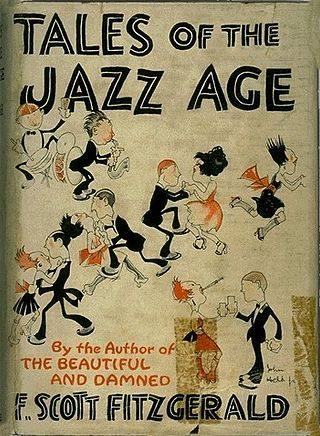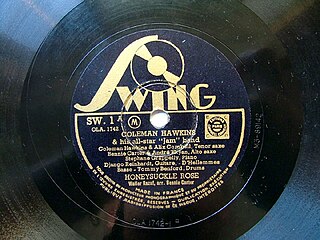Related Research Articles

The Mills Blue Rhythm Band was an American big band active during the 1930s.
The International Sweethearts of Rhythm was the first integrated all-women's band in the United States. During the 1940s the band featured some of the best female musicians of the day. They played swing and jazz on a national circuit that included the Apollo Theater in New York City, the Regal Theater in Chicago, and the Howard Theater in Washington, D.C. After a performance in Chicago in 1943, the Chicago Defender announced the band was "one of the hottest stage shows that ever raised the roof of the theater!" They have been labeled "the most prominent and probably best female aggregation of the Big Band era". During feminist movements of the 1960s and 1970s in America, the International Sweethearts of Rhythm became popular with feminist writers and musicologists who made it their goal to change the discourse on the history of jazz to include both men and women musicians. Flutist Antoinette Handy was one scholar who documented the story of these female musicians of color.
The Eureka Brass Band was a brass band from New Orleans, active from 1920 to 1975, that recorded prolifically for Atlantic Records, Pax, Alamac, Folkways, Jazzology, and Sounds of New Orleans.

Joseph Vankert Thomas was an American jazz tenor saxophonist and vocalist.

This is a timeline documenting events of Jazz in the year 1915.

This is a timeline documenting events of Jazz in the year 1947.

This is a timeline documenting events of Jazz in the year 1930.

This is a timeline documenting events of Jazz in the year 1922.

This is a timeline documenting events of Jazz in the year 1923.

This is a timeline documenting events of Jazz in the year 1937.
The Harlem Playgirls was an African American swing band active in the Midwest and throughout the United States from the mid-1930s to the early 1940s.
The Prairie View Co-eds were an all-female band that formed in the 1940s at the historically black Prairie View A&M University. The band formed in response to more and more males being drafted into the armed forces. The Prairie View Co-eds' success soon spread past the limits of their college campus though, and they were soon touring and traveling much of the year.
Sherrie Jean Tucker is a musicologist, music historian, book author, professor, and journal editor. Tucker is co-editor-in-chief of American Studies, peer-reviewed academic journal.
Dolly Jones,, also known as Doli Armenra and Dolly Hutchinson, was a jazz trumpet and trombone player. She was the first female jazz trumpeter to be recorded.
There were two independently created and independently operating groups known as the Melodears or Melo-Dears in the 1930s and 1940s, one a band, the other a vocal trio, with similar names only by coincidence. There is no known connection between the two groups.
Pauline Braddy Williams was an American jazz drummer. She drummed with the International Sweethearts of Rhythm, an integrated, all-female swing band, from 1939 to 1955; Braddy herself was African-American. Braddy was known as "Queen of the Drums".
This is a timeline documenting events of jazz in the year 1909.
Eddie Durham's All-Star Girl Orchestra was an African-American all-female band started by arranger Eddie Durham in January 1942. By November, the All-Stars were a part of Moe Gale's New York agency. The group was also known as "Eddie Durham's All-Girl Band" and performed throughout the country and internationally. The All-Stars typically had between eighteen and twenty-two members and pulled musicians from other popular bands of the time, including The Harlem Playgirls and The International Sweethearts of Rhythm.
The Dixie Sweethearts were an all-women jazz group in the 1930s. Members of the group have later played with other similar acts like the Harlem Playgirls and the Darlings of Rhythm with individual members continuing to perform through the 1940s. The group was led by frontwomen Marjorie Ross and Madge Fontaine. Other members included Tiny Davis, Marjorie Pettiford, Violet Burnside, Henrietta Fontaine, who joined the spin-off group Darlings of Rhythm in the 1940s.
Rosalind Cron was an American alto-saxophonist. During the 1940s she played with the International Sweethearts of Rhythm, an all-female jazz big band. She toured and performed for American soldiers in post-war Europe and was broadcast on national and international radio.
References
- 1 2 Tucker, Sherrie (Autumn 1998). "Nobody's Sweethearts: Gender, Race, Jazz, and the Darlings of Rhythm". American Music. 16 (3): 255–288. doi:10.2307/3052637. JSTOR 3052637.
- ↑ Carl J. Schneider; Dorothy Schneider (1 January 2009). World War II. Infobase Publishing. p. 106. ISBN 978-1-4381-0890-2.
- 1 2 3 4 Sherrie Tucker (6 June 2000). Swing Shift: "All-Girl" Bands of the 1940s . Duke University Press. p. 218. ISBN 0-8223-8090-0.
- ↑ Handy, D. Antoinette (1983). The International Sweethearts of Rhythm. Metuchen, N.J., & London: The Scarecrow Press, inc. p. 190.
- ↑ Kristin A. McGee (2009). Some Liked it Hot: Jazz Women in Film and Television, 1928–1959. Wesleyan University Press. p. 254. ISBN 978-0-8195-6908-0.